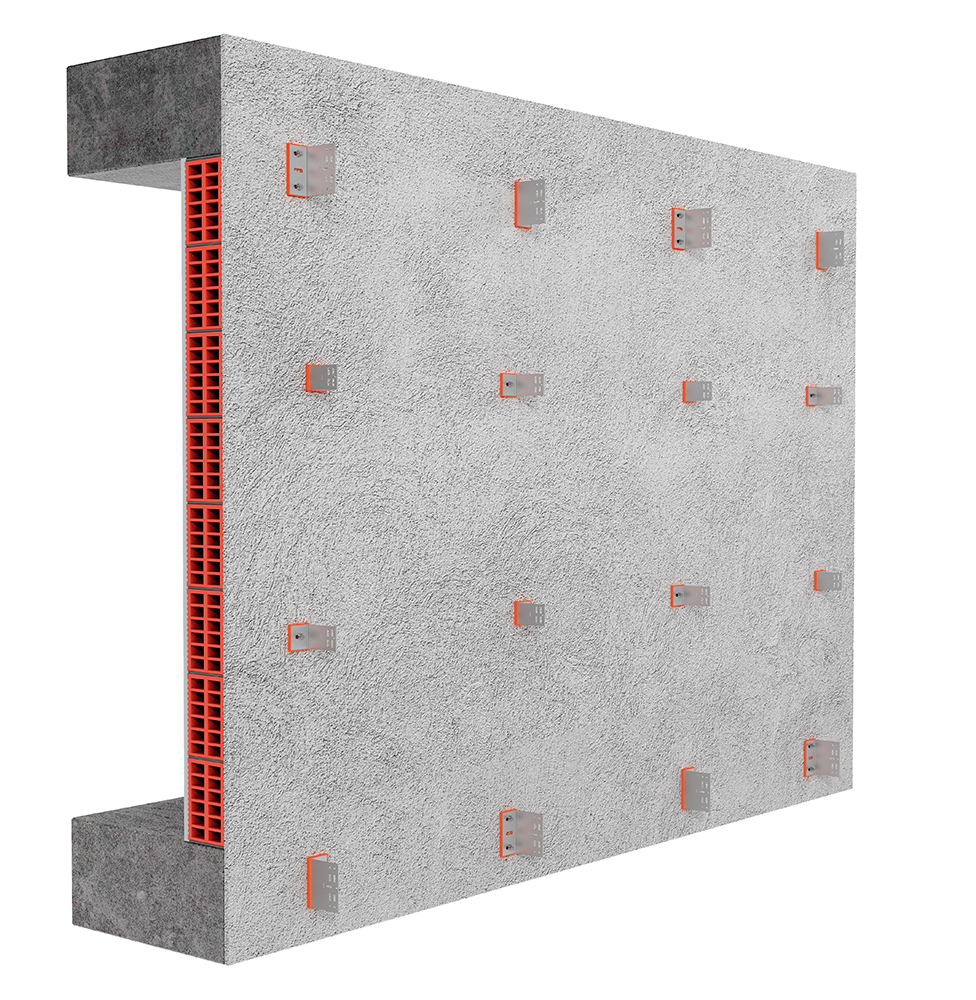Ventilated facades – exa | TECH |
As part of its desire to continue expanding its catalogue of comprehensive technical solutions for construction projects, Exagres presents its all-new line of exa-TECH ventilated facades.
Exa-TECH is a ventilated facade system that comes with high-tech extruded porcelain ceramic panelling that is compatible with most profiling and anchoring systems currently on the market.
This construction method has burst onto the scene to provide projects with a state-of-the-art architectural solution, giving the project the best performance against the elements and offering a fast, economical and environmentally friendly installation solution with a wide variety of exterior cladding for ventilated façades.

What is a ventilated facade?
A ventilated facade is an enclosure construction solution with a ventilated cavity between the exterior wall tiling panels and the support or interior partition walls.
The ventilated cavity allows the exit and entry of air through its openings (bottom and top) as well as between the panel open joints.
The origin of ventilated facade systems arises from the need to protect structures from snow and rain. It’s a double-layer system formed by two enclosure leaves with a separation between to create a cavity allowing the circulation of an air flow that eliminates any type of humidity.
Why use the exa | TECH | FVH system?
The exa-TECH FVH ventilated facade system is a set of elements that form a self-supporting substructure that is solidly attached to the support where it is installed. The slotted exa-TECH FVH panels are used to cover facades using this system.





Characteristics of ventilated facades
Sustainable architecture, which fosters energy efficiency and the use of environmentally-friendly materials, is on the rise and ventilated facades feature a series of characteristics and basic elements offering a clear advantage as concerns insulation and energy savings. The basic characteristics and elements comprising a ventilated facade are as follows:



Base Material: It is the support where the ventilated facade system is fixed to (it is not part of the system itself).
Thermal insulation: Installed over the backing wall to improve its thermal and acoustic performance and removing the thermal bridges.
Ventilated air chamber: With a minimum size of 30 mm, thanks to the chimney effect that is produced, it helps the diffusion of water vapour from the interior and water that may penetrate due to rain.
Substructure:
· Anchors: these are the ventilated façade fixings that connect the system to the base material to transmit the loads supported by the latter.
·Brackets: components of the substructure that make it possible to separate the cladding from the inner leaf of the building envelope.
·Profiles: longitudinal elements that are fixed to the brackets and support the facade cladding panels.
Fixing system: elements that fix or fasten the external cladding of ventilated facades to the profiles.
Cladding panels: it constitutes the external layer of the facade.





Advantages of ventilated facades
Installing a ventilated facade offers a series of benefits over traditional systems. The most important are listed below:
1. Continuous thermal insulation.
2. The building heat absorption in summer is significantly reduced.
3. The inner layer accumulates internal heat in winter.
4. Less condensation and moisture problems due to the constantly renewed air.
5. The external layer of the system works as a protective barrier against atmospheric agents, an effect known as “RAIN SCREEN”.
6. Enhances the acoustic performance.

Types of ventilated facades
If we were to classify the types of ventilated facades, we could categorise them according to their material, finish or fixing system. The exa-TECH ventilated facades are the best option in the construction and renovation of buildings thanks to their high resistance to UV rays, high durability and almost zero water absorption.
Some of the most commonly used materials and finishes are as follows:

Ceramic ventilated facades
The demand for ceramic ventilated facades is on the rise. Much of this success is due to the excellent technical characteristics of this material which offer immense hardness and high resistance to adverse climate conditions.
Moreover, exa-TECH has a large catalogue of collections with a great variety of finishes that can be adapted to any home or building design or style such as marble ventilated facades.
Stone ventilated facades
Another popular trend is stone ventilated facades. Their rustic and timeless character makes exa-TECH's digital printing collections a success.


Wood ventilated facades
The authentic character of wood can also be maintained with porcelain wood ventilated facades which combine the warmth of this material with the strength and durability of ceramics.
Ventilated facade price
Due to its immense break resistance and easy assembly, this type of ventilated facade can be adapted to the needs and technical requirements of any project. If you’re interested in finding out the price of an exa-TECH ventilated facade, please contact us by completing the contact form.



exa-TECH offers a wide variety of pieces in different formats and finishes in line with the latest trends in architecture.
Several collections are available with textured full body panels in different tones and with the advantage that the panel thickness is the same tone as the rest of the piece.
Plus, there are different types of exa-TECH products with graphics applied using inkjet digital technology to recreate different kinds of cement, wood, marble or stone.

































